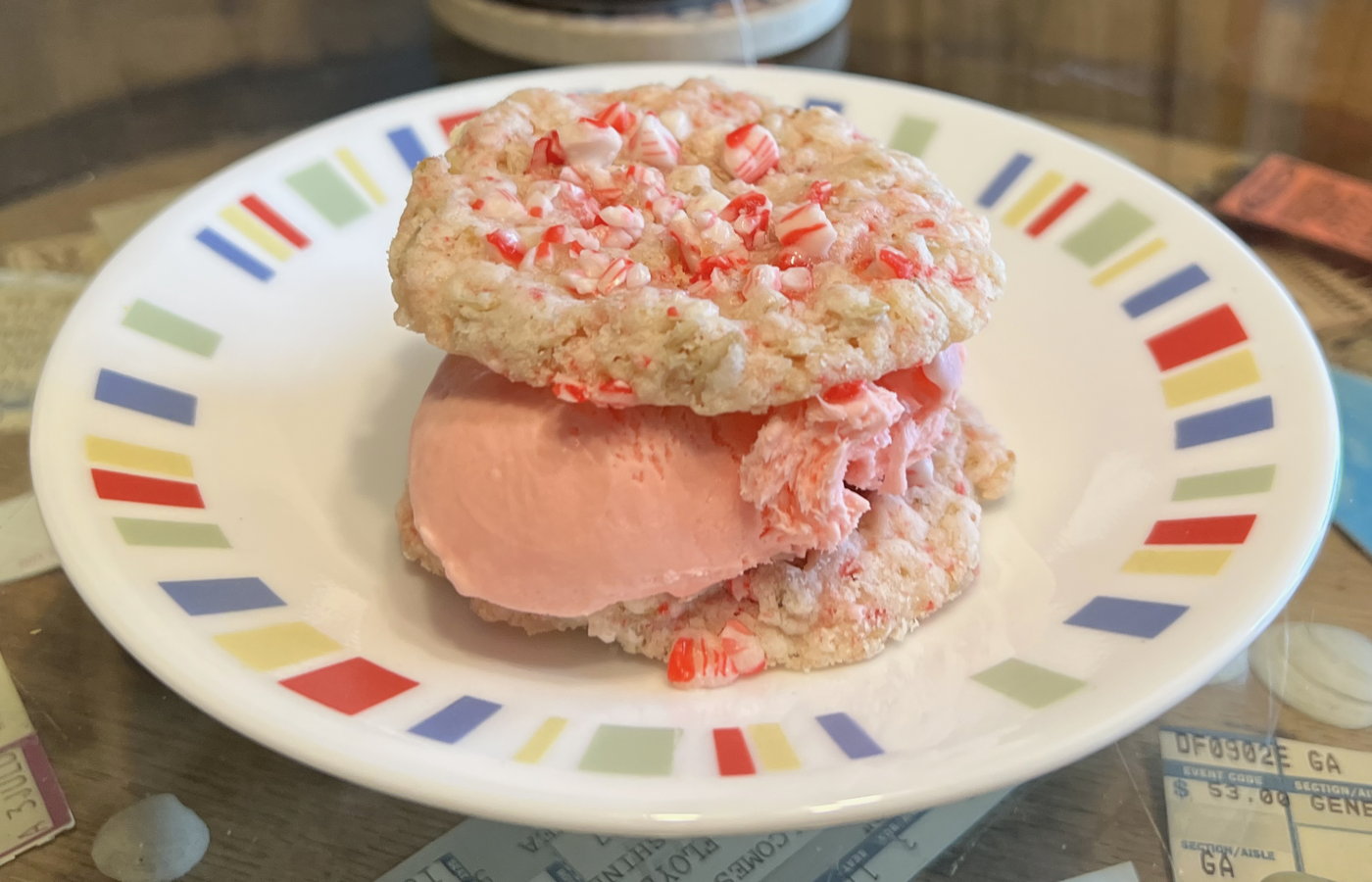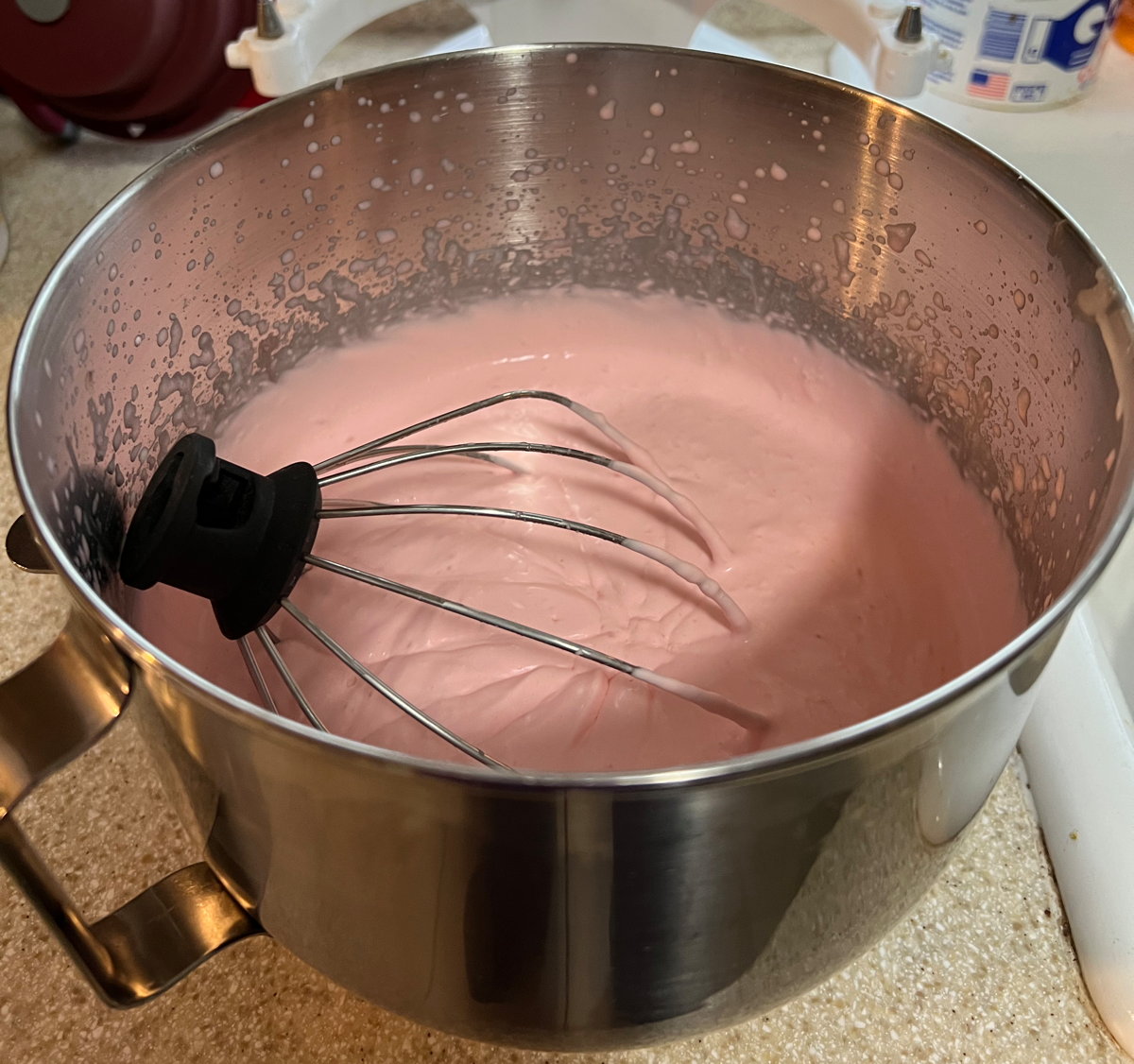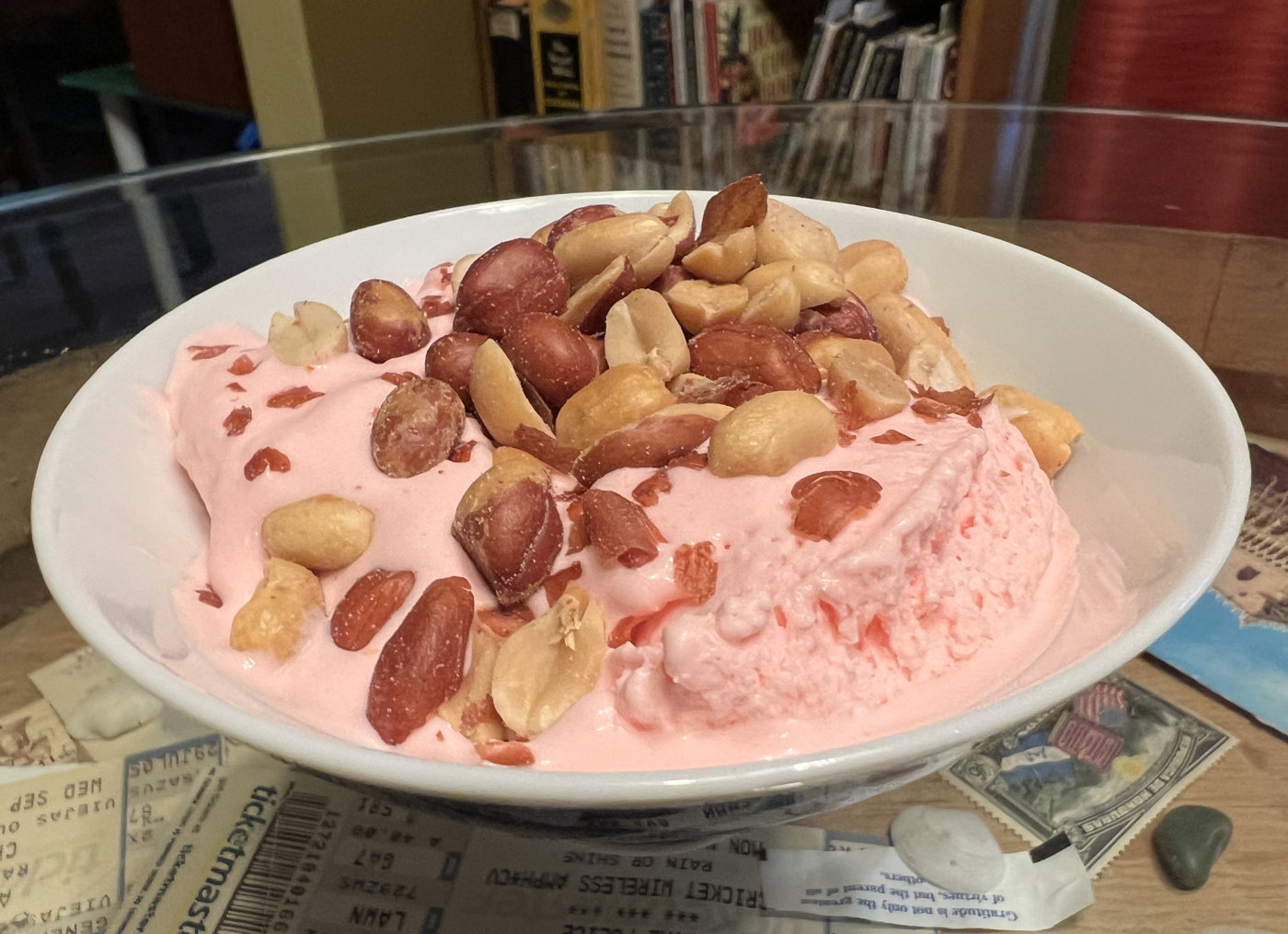Easter Candy-Cane Ice Cream
Candy canes are a shepherd’s staff. At Christmas, the shepherds were witnesses to Christ’s birth. By Easter, Christ is the good shepherd, giving his life for his lost lambs.
Servings: 8
Preparation Time: 4 hours
Miss Verna L. Miller
Frigidaire Recipes (PDF File, 15.5 MB)
Ingredients
- ½ lb candy canes, ground or crushed
- 1 cup milk
- 2 cups whipping cream
Steps
- Dissolve candy canes in milk in the top of a double boiler.
- Chill in the refrigerator.
- Put in the freezer until very thick and syrupy.
- Chill a mixer bowl, beater, and storage container along with it.
- Remove syrup and beat quickly, adding the heavy cream while beating.
- When whipped light and frothy, pour into the chilled storage container and return to the freezer for several hours or overnight.
As regular followers of Mimsy Were the Borogoves know, I have a tradition that spans from Christmas to Easter. I keep the candy canes from Christmas and make a dessert from them to help celebrate Easter Sunday.
There is a spiritual meaning to the ubiquitous Christmas candy cane. Whether that meaning was part of their invention or not, we don’t know, but as Catholics often do, we have invested this celebratory food with spiritual meaning. We just don’t know if that meaning was part of the candy cane tradition from the start. Once you see it, however, it’s hard to forget: the candy cane is a shepherd’s staff. The next time you see a nativity painting, take a look at the staffs the shepherds are holding. Very likely, they’re going to have the same shape as a candy cane.
Even today, the curved shepherd’s staff is ubiquitous in Catholic ritual. Every bishop has one. Their crozier is a shepherd’s staff, and it has the candy cane loop.
Candy canes also—turn one upside down—represent the letter “J”. Of all the symbolism attributed to the candy cane, this, I’ll admit, is most likely to be ex post facto.
The white and the red, much like a barber’s sign where the colors represent blood and bandages1 represent Christ’s blood and purity.
There’s much more to it than that, of course and so much of the candy cane’s origins are lost to legend. Did the candy’s crooked shape come first, which was then associated with Christmas? Or did someone take the ubiquitous straight candies (still often found marketed as “old-fashioned” candy sticks in small-town variety stores) and turn it into a crook for Christmas? Were the canes originally all-white, and only later get a red stripe? Like most traditions, at some point someone started doing it, the idea took root, and it spread.
That said, it’s difficult to look at the ubiquitous Christmas candy cane and the ubiquitous Christmas nativity imagery and not see some connection between the cane’s shape and a shepherd’s staff.

The shape of the staffs isn’t nearly as obvious in this seventeenth century Jacob Jordaens painting, The Adoration of the Shepherds, but if you look closely you can see the classic crooked staff.

They make great ice cream sandwiches with last year’s Candy cane oatmeal crispies.
I did not know any of that, explanation or controversy, when I started this tradition. I just thought it would be a nice way of remembering Christmas at Easter, and of looking toward Easter at Christmas.
As regular followers of this blog also know, I enjoy homemade ice cream. I have collected several ice cream recipes that require very little work, and no cranking at all.
This year, it’s time to combine these passions.2
The earliest refrigerator manual I have in my collection is the 1928 Frigidaire Recipes. Among the many wonderful ice creams meant to be made in your new and revolutionary home refrigerator is a “Peppermint Candy Ice Cream” that uses “peppermint stick candy”. It’s a very simple recipe: the three ingredients are peppermint sticks, milk, and cream. The candy canes provide all the sugar you need—it uses a half pound of canes.
It ought to be a great method for turning any leftover hard candy into ice cream. Dissolve the candy in milk, chill, and beat with whipping cream. Lemon drops and butterscotch candies come to mind as strong possibilities.
One of the really neat things about the Frigidaire manual is that they were trying to treat the refrigerator as an appliance for cooking much like the oven. There was a “Cold Control” on the freezer and it was meant to be adjusted depending on what you were making in the freezer, just as you would adjust the heat control on your oven.

Chill the mixing bowl in the freezer along with the syrup, so that it’s cold when you start whipping.
The recipe for Peppermint Candy Ice Cream instructed the reader to “Follow Method III for setting Cold Control and Method II for freezing desserts.”
Method III (for Setting Cold Control)
When mixture is cool, pour into tray and allow to chill, then set Cold Control in 6th position until dessert is frozen. After the dessert is frozen, turn the Cold Control back to 2nd or 3rd position until dessert is served.
Method II (of Freezing Desserts)
Desserts such as ice creams, sherbets and ices must be agitated by stirring with a spoon from front to back of tray during the freezing process.
When mixture is properly chilled in Frigidaire, pour into tray and allow to freeze, agitating at half-hour intervals until frozen to a mushy consistency. Finish freezing without further agitating.
Nowadays we don’t need to worry so much about any of that. Modern freezers are, I suspect, a lot colder than freezers from 1928 and a lot more efficient. So chilling in the refrigerator and then further in the freezer removes any need to stir it regularly. Or even, as it seems to be saying, any need to wait until it freezes over completely.
As you can see from the photos, this makes an elegant pastel-pink ice cream perfect for an Easter Sunday dessert, or for an afternoon snack with cake, cookies, or brownies.
In response to Holiday food: From Christmas to Easter to Independence Day and more, holidays are times for sharing great food.
Barbers were originally also surgeons. Some barbers add blue to the mix, but this is not universal.
↑Pun very much intended.
↑
ice cream
- Ice cream from your home freezer
- You can make great ice cream with whole eggs, egg yolks, and egg whites. You can even make it without eggs at all. All you need is syrup and cream—and a refrigerator with a freezer or a standalone home freezer.
- Ice creamy: more no-churn ice cream recipes
- If eight ice cream recipes isn’t enough, how about six more? Try ice cream with evaporated milk, condensed milk, and with nothing but cream.
- Summer Ices Part Three: A Trilogy of Frozen Desserts
- In what is rapidly becoming a new tradition, here are two more ice creams plus an icy sorbet to help cool your summer in 2024.
refrigerators
- Refrigerator Revolution Revisited: 1928 Frigidaire
- The 1928 manual and cookbook, Frigidaire Recipes, assumes a lot about then-modern society that could not have been assumed a few decades earlier.
- Revolution: Home Refrigeration
- Nasty, brutish, and short. Unreliable power is unreliable civilization. When advocates of unreliable energy say that Americans must learn to do without, they rarely say what we’re supposed to do without.
More candy canes
- Peppermint Popcorn for Easter
- If you still have candy canes left from Christmas, consider them for an Easter-pink caramel corn. Hard candies make a great flavoring for popcorn—but watch out for the color mixes!
More Easter
- Peppermint Popcorn for Easter
- If you still have candy canes left from Christmas, consider them for an Easter-pink caramel corn. Hard candies make a great flavoring for popcorn—but watch out for the color mixes!
- Hope Lutheran 1950 Lenten fish au gratin
- One of the interesting things about old calendars that are also something else—such as a cookbook—is that they follow seasons that no longer exist.
- Candy cane oatmeal crispies
- These candy cane cookies are a great way to use up post-Christmas candy canes. You might even want to hit the after-Christmas sales just to get canes to make these with.
More ice cream
- Four New Ices and an Ice Cream Cookery
- Philadelphia Ice Cream, Walnut Nougat, Lemon Cream Sherbet, and Cranberry Ice. Four more new no-churn ice creams and desserts for Summer 2025. And, a book collecting all my favorite no-churn ice creams if you’re interested!
- Refrigerator Revolution Revisited: 1947 Cold Cookery
- The 1947 Norge Cold Cookery and Recipe Digest reflects not just increased access to electricity but also the end of a second world war.
- Summer Ices Part Three: A Trilogy of Frozen Desserts
- In what is rapidly becoming a new tradition, here are two more ice creams plus an icy sorbet to help cool your summer in 2024.
- Ice creamy: more no-churn ice cream recipes
- If eight ice cream recipes isn’t enough, how about six more? Try ice cream with evaporated milk, condensed milk, and with nothing but cream.
- Ice cream from your home freezer
- You can make great ice cream with whole eggs, egg yolks, and egg whites. You can even make it without eggs at all. All you need is syrup and cream—and a refrigerator with a freezer or a standalone home freezer.




